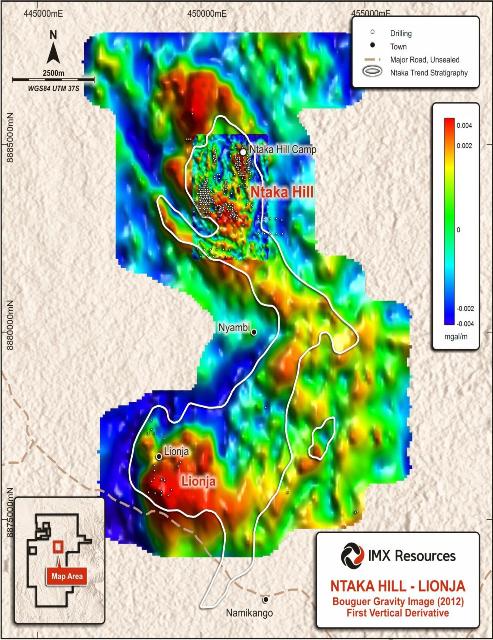Nov 20 2013
IMX Resources Limited is pleased to report on the work program of its partner MMG Limited ('MMG') at the Nachingwea Exploration Project, which includes the Ntaka Hill Nickel Sulphide Project, located in south-east Tanzania.
 Ntaka Hill Nickel Sulphide Project Area, including the Lionja Prospect
Ntaka Hill Nickel Sulphide Project Area, including the Lionja Prospect
On 19 September, IMX and MMG entered into a five year, US$60 million earn-in and joint venture ('JV') agreement, with MMG assuming responsibility for management of the Nachingwea Exploration Project shortly thereafter. Since taking over management, MMG has focussed on identifying targets for the 2014 drilling program, using a range of geophysical methods and geological data bases. In addition, MMG is carrying out diamond drilling to test for mineralisation down plunge of existing near surface high-grade mineralisation. MMG is targeting a resource in the order of 27 million tonnes at 1.5% Ni for 400,000 tonnes of contained nickel.
The initial work program defined by MMG has the primary objective of rapid evaluation of the potential for high-grade nickel discoveries and successful achievement of this resource target. The budget for the initial work program is US$10 million and includes 16,000m of diamond drilling and 8,000m of reverse circulation ('RC') drilling. MMG is specifically targeting high-grade nickel mineralisation within southerly plunging conduits or tubular bodies known as chonoliths. Exploration for these targets is best achieved using a combination of 'deep looking' geophysical techniques, targeted drilling and follow up downhole electro-magnetic ('EM') surveys.
Geophysical surveys including NSAMT (natural source audio magnetotellurics), ground electro magnetics using a state of the art high sensitivity ARMIT sensor and surface gravity together with surface geological mapping and further soil sampling are being used to generate targets for drill testing. This work will be completed in time for drilling of targets to commence in early 2014 following the wet season.
The MMG work program includes a regional exploration program over the Ntaka-Lionja Corridor and other regional tenements.
The Ntaka-Lionja Corridor comprises an area of approximately 60 square kilometres that extends from the southern edge of Ntaka Hill, south to Lionja. It has previously been identified as having similar characteristics and host rocks to the Ntaka ultramafic intrusive complex. Magnetics and gravity data suggest the potential for additional ultramafic intrusions between the two prospects. Exploration will be guided by soil survey and gravity survey results and NSAMT/EM work currently underway.